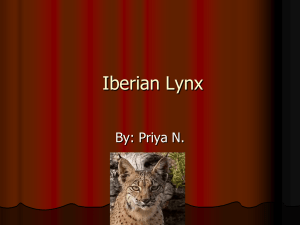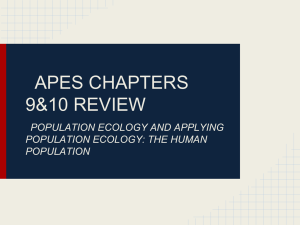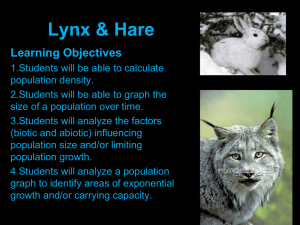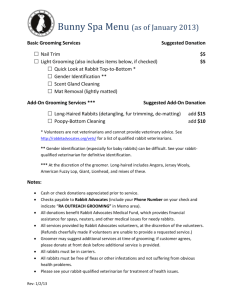jane12226-sup-0001-FigS1-S4-TableS1-S5-References
advertisement
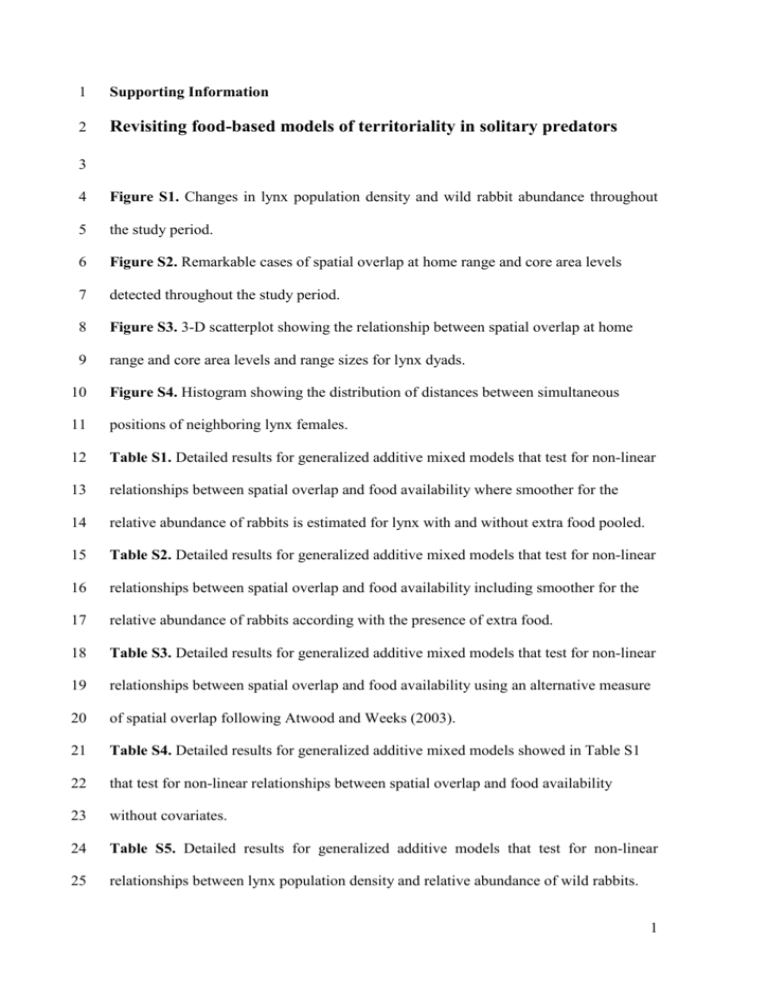
1 Supporting Information 2 Revisiting food-based models of territoriality in solitary predators 3 4 Figure S1. Changes in lynx population density and wild rabbit abundance throughout 5 the study period. 6 Figure S2. Remarkable cases of spatial overlap at home range and core area levels 7 detected throughout the study period. 8 Figure S3. 3-D scatterplot showing the relationship between spatial overlap at home 9 range and core area levels and range sizes for lynx dyads. 10 Figure S4. Histogram showing the distribution of distances between simultaneous 11 positions of neighboring lynx females. 12 Table S1. Detailed results for generalized additive mixed models that test for non-linear 13 relationships between spatial overlap and food availability where smoother for the 14 relative abundance of rabbits is estimated for lynx with and without extra food pooled. 15 Table S2. Detailed results for generalized additive mixed models that test for non-linear 16 relationships between spatial overlap and food availability including smoother for the 17 relative abundance of rabbits according with the presence of extra food. 18 Table S3. Detailed results for generalized additive mixed models that test for non-linear 19 relationships between spatial overlap and food availability using an alternative measure 20 of spatial overlap following Atwood and Weeks (2003). 21 Table S4. Detailed results for generalized additive mixed models showed in Table S1 22 that test for non-linear relationships between spatial overlap and food availability 23 without covariates. 24 Table S5. Detailed results for generalized additive models that test for non-linear 25 relationships between lynx population density and relative abundance of wild rabbits. 1 26 Figure S1. Changes in lynx population density (individuals 100 km-2; only sub-adult 27 and adult individuals, see text for details) and the relative abundance of wild rabbits 28 (rabbits km-1, see text for details) throughout the study period (note that both estimates 29 are only shown for those years with data on lynx spatial ecology. Circles denote records 30 of lynx population density in Vera (VE, black), and Coto del Rey (CR, grey). Upward 31 triangles refer to the annual maximum relative abundance of wild rabbits (between April 32 and July), whereas downward triangles refer to the annual minimum (between August 33 and November). Black triangles refers to VE and grey triangles to CR. 34 VE CR 14 25 12 10 15 8 10 6 -1 20 4 5 2 0 1985 35 16 Wild rabbits km -2 Lynx density (individuals 100 km ) 30 0 1990 1995 2000 2005 2010 Year 36 37 2 38 Figure S2. Occasional cases of remarkable spatial overlap of home ranges (HR; 90% 39 probability contour of positions distribution) and core areas (CA, 50% probability 40 contour of positions distribution). Black boxes above the X-axis indicate years with 41 lynx data (12 years). Large grey open circles denote cases recorded between August and 42 November (i.e. low rabbit abundance period). The vertical dashed line separates cases 43 between areas (VE and CR). Shaded areas denote extraordinary events: the rabbit 44 population crash following the introduction of the rabbit haemorrhagic disease in 1990 45 (Moreno et al. 2007), a period of heavy rains (1995-1997) that further decimated the 46 rabbit population (Palomares 2003), and experimental supplementation of food between 47 2004 and 2008 (López-Bao, Rodríguez & Palomares 2008). The vertical white line 48 denotes the outbreak of the feline leukemia virus in CR in 2007, which led to the death 49 of 5 lynx in this area in a 6-month period (Meli et al. 2009). HR overlap CR VE CA overlap 0.6 Spatial overlap 0.5 0.4 0.3 0.2 0.1 1985 50 1990 1995 2000 2005 2010 Year 51 3 52 References 53 López-Bao, J.V., Rodríguez, A. & Palomares, F. (2008) Behavioural response of a 54 trophic specialist, the Iberian lynx, to supplementary food: patterns of food use and 55 implications for conservation. Biological Conservation, 141, 1857˗1867. 56 Meli, M.L., Cattori, V., Vargas, A., Martínez, F., López, G., Zorrilla, I., Muñoz, A., 57 Palomares, F., López-Bao, J.V., Pastor, J., Tandon, R., Willi, B., Hofmann-Lehmann, R. 58 & Lutz, H. (2009) Feline leukemia virus and other pathogens as important threats to the 59 survival of the critically endangered Iberian Lynx (Lynx pardinus). PLOS ONE, 4, 60 e4744. 61 Moreno, S., Beltrán, J.F., Cotilla, I., Kuffner, B., Laffitte, R., Jordán, G., Ayala, J., 62 Quintero, M.C., Jiménez, A., Castro, F., Cabezas, S. & Villafuerte, R. (2007) Long-term 63 decline of the European wild rabbit (Oryctolagus cuniculus) in south-western Spain. 64 Wildlife Research, 34, 652-658. 65 66 Palomares F. (2003) The negative impact of heavy rains on the abundance of a Mediterranean population of European rabbits. Mammalian Biology, 68, 224–234. 67 68 69 70 71 72 73 74 75 76 4 77 Figure S3. 3-D scatterplot showing the relationship between spatial overlap of home 78 ranges (HR; 90% probability contour of positions distribution) and core areas (CA, 50% 79 probability contour of positions distribution) and range sizes (HR and CA) for dyads of 80 neighbouring lynx (individuals A and B). 0.6 0.5 0.4 HR overlap 0.3 0.2 0.1 0.0 70 60 50 40 30 20 2 10 10 Home range A (km ) 15 20 Home range B (km2) 5 0 35 30 25 0 0.25 0.20 0.15 CA overlap 0.10 0.05 0.00 14 12 10 8 2 81 Core Area A (km ) 6 4 2 0 0 2 4 6 8 18 16 14 12 10 Core area B (km2) 82 83 84 5 85 Figure S4. Histogram showing the distribution of distances between simultaneous 86 positions of neighboring lynx females (500 m intervals). Grey bar: 0 - 500 m interval. 87 88 89 90 91 92 93 94 95 96 97 98 6 99 Table S1. Parameter estimates (± SE) in the generalized additive mixed models that test 100 for non-linear relationships between spatial overlap and food availability. A smoother 101 for the relative abundance of wild rabbits (rabbit availability) is estimated for lynx with 102 and without extra food pooled. The levels “extra food (absence)” and “area (VE)” are 103 included in the intercept. BIC = Bayesian Information Criterion. BIC tends to be more 104 conservative and less prone to over-parameterization than Akaike’s information 105 criterion (Bolker 2008). Home range estimate SE Parametric coefficients: Intercept Extra food (presence) Area (CR) Radio-tracking effort 0.75 0.12 -0.41 -0.01 0.207 0.074 0.102 1 3.08 BIC = 42.46 P 0.001 0.21 0.09 0.22 0.01 Smooth terms: ƒ (rabbit availability) ƒ (lynx density) 106 107 edf Core area estimate SE 0.22 -0.07 -0.05 -0.01 edf 0.050 0.11 0.04 0.07 0.01 0.603 0.036 P 0.175 0.450 0.108 1 2.86 0.742 0.104 BIC = 6.68 edf = estimated degrees of freedom 108 109 110 111 References Bolker, B.M. (2008) Ecological Models and Data in R. Princeton University Press, Princeton, NJ, USA. 112 113 114 115 116 7 117 Table S2. Parameter estimates (± SE) in the alternative generalized additive mixed 118 models that test for non-linear relationships between spatial overlap and food 119 availability including smoothers for the relative abundance of wild rabbits during 120 periods with and without extra food. The levels “extra food (absence)” and “area (VE)” 121 are included in the intercept. BIC = Bayesian Information Criterion. Home range Parametric coefficients: Intercept Extra food (presence) Area (CR) Radio-tracking effort estimate SE 0.76 0.12 -0.41 -0.01 0.22 0.10 0.22 0.01 Smooth terms: ƒ (rabbit availability) x absence of extra food ƒ (rabbit availability) x presence of extra food ƒ (lynx density) BIC = 53.11 122 123 edf Core area P 0.001 0.246 0.075 0.127 estimate SE 0.13 -0.05 -0.01 -0.01 edf 0.10 0.05 0.08 0.01 P 0.230 0.362 0.856 0.478 1 0.731 3.22 0.133 1 0.647 1.77 0.413 3.05 0.029 2.36 0.026 BIC = 13.29 edf = estimated degrees of freedom 124 125 126 127 128 129 130 131 8 132 Table S3. Parameter estimates (± SE) in the generalized additive mixed models that test 133 for non-linear relationships between spatial overlap and food availability using an 134 alternative measure of spatial overlap proposed by Atwood and Weeks (2003). Based on 135 the size of adaptive kernel estimates of lynx home ranges (HR, 90% probability contour 136 of positions distribution) and core areas (CA, 50% probability contour of positions 137 distribution), spatial overlap indices were calculated as follow: 138 Overlap index = [(areaAB/sizeA) x (areaAB/sizeB)]0.5 139 where areaAB is the area shared (overlapped) at either HR or CA level, and sizeA and 140 sizeB are the individual sizes of HR or CA, respectively. Overlapped areas and the size 141 of HR and CA were calculated using ArcGIS 9 (ESRI, California, USA). Modeling 142 procedures and factors are explained in the methods section. The levels “extra food 143 (absence)” and “area (VE)” are included in the intercept. Home range Parametric coefficients: Intercept Extra food (presence) Area (CR) Radio-tracking effort estimate SE 0.76 0.16 -0.50 -0.01 0.18 0.09 0.19 0.01 Smooth terms: ƒ (rabbit availability) ƒ (lynx density) 144 edf Core area P 0.001 0.085 0.013 0.545 1.27 4.50 0.235 0.001 estimate SE 0.19 0.03 -0.16 -0.01 edf 0.14 0.07 0.11 0.01 P 0.176 0.610 0.142 0.852 1 2.93 0.235 0.044 edf = estimated degrees of freedom 145 146 References 147 Atwood, T.C. & Weeks, H.P. (2003) Spatial home-range overlap and temporal 148 interaction in eastern coyotes: The influence of pair types and fragmentation. Canadian 149 Journal of Zoology, 81, 1589-1597. 9 150 Table S4. Parameter estimates (± SE) in the generalized additive mixed models that test 151 for non-linear relationships between spatial overlap and food availability (see Table S1) 152 without covariates (area, lynx population density, radio-tracking effort). A smoother for 153 the relative abundance of wild rabbits (rabbit availability) is estimated for lynx with and 154 without extra food pooled. The level “extra food (absence)” is included in the intercept. Home range estimate SE Parametric coefficients: Intercept Extra food (presence) Smooth terms: ƒ (rabbit availability) 155 156 0.30 0.12 edf Core area P 0.001 0.08 0.10 0.238 1.41 0.783 estimate SE 0.07 -0.05 edf P 0.100 0.04 0.05 0.314 1 0.559 edf = estimated degrees of freedom 157 158 159 160 161 162 163 164 165 166 167 168 169 10 170 Table S5. Detailed results of four generalized additive models that test for non-linear 171 relationships between lynx population density (individuals 100 km-2; only sub-adult and 172 adult individuals, see text for details) and four estimates of the relative abundance of 173 wild rabbits (rabbits km-1, denoted as "WRA" in the table) throughout the study period 174 in VE and CR (total number of areas*year = 14). We tested four different estimates of 175 relative abundance of wild rabbits: the maximum (spring) and minimum (autumn) 176 values of wild rabbit abundance the same year, and the year before, that lynx population 177 density was recorded. We considered the maximum and the minimum values of rabbit 178 availability because they are proxies of two population processes affecting lynx density: 179 Productivity may be associated with prey availability in spring, whereas survival may 180 be associated with prey availability in autumn. The year before was considered to 181 explore the influence of time-delayed effects of prey availability on lynx population 182 density. The presence/absence of extra food and the area were considered as covariates 183 in all models. 184 MODEL considering: Parametric coefficients: Extra food Area Smooth terms: ƒ (WRA) 185 186 Maximum WRA the same year F df 2.22 32.3 1 1 P Minimum WRA the same year F 0.117 2.26 0.001 26.6 edf 0.07 1 df 1 1 P Maximum WRA the year before F 0.164 1.72 0.001 26.9 1 1 1 P F 0.219 3.56 0.001 35.3 edf edf 0.799 0.01 df Minimum WRA the year before 0.977 0.88 1 df P 1 1 0.105 0.001 edf 0.369 2.97 3.6 edf = estimated degrees of freedom 11 0.107


